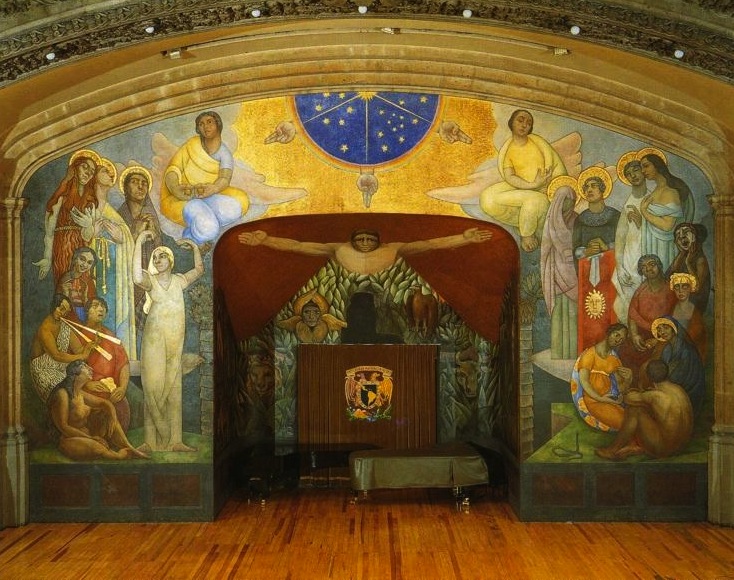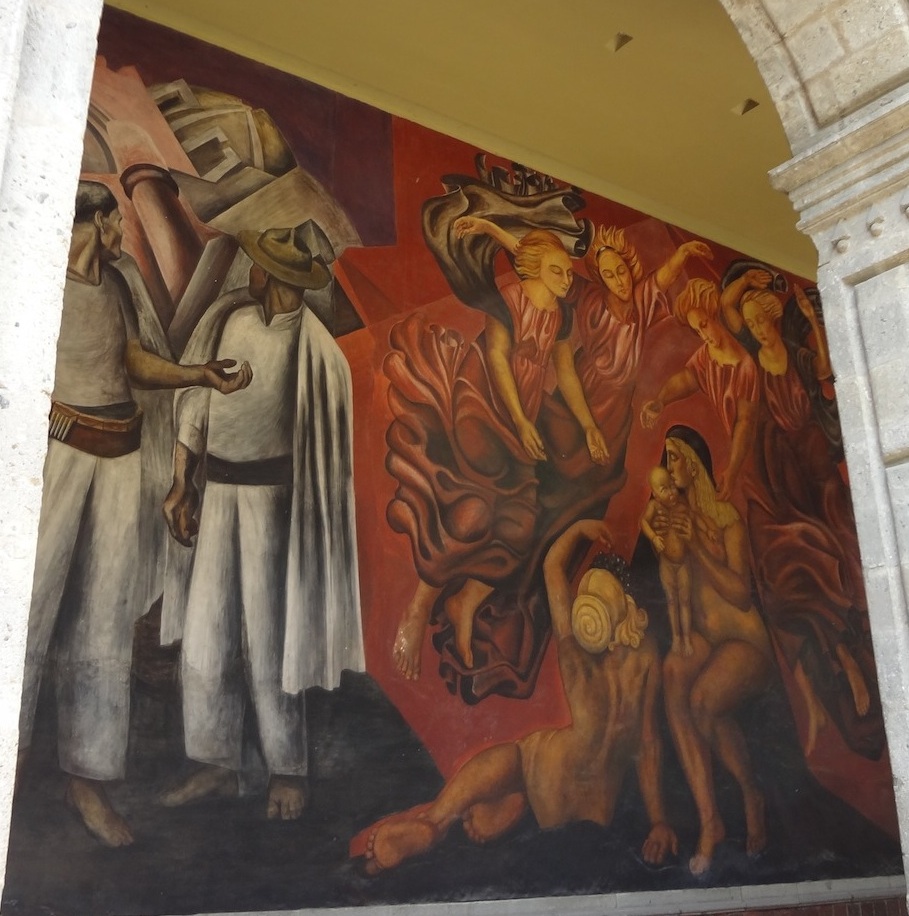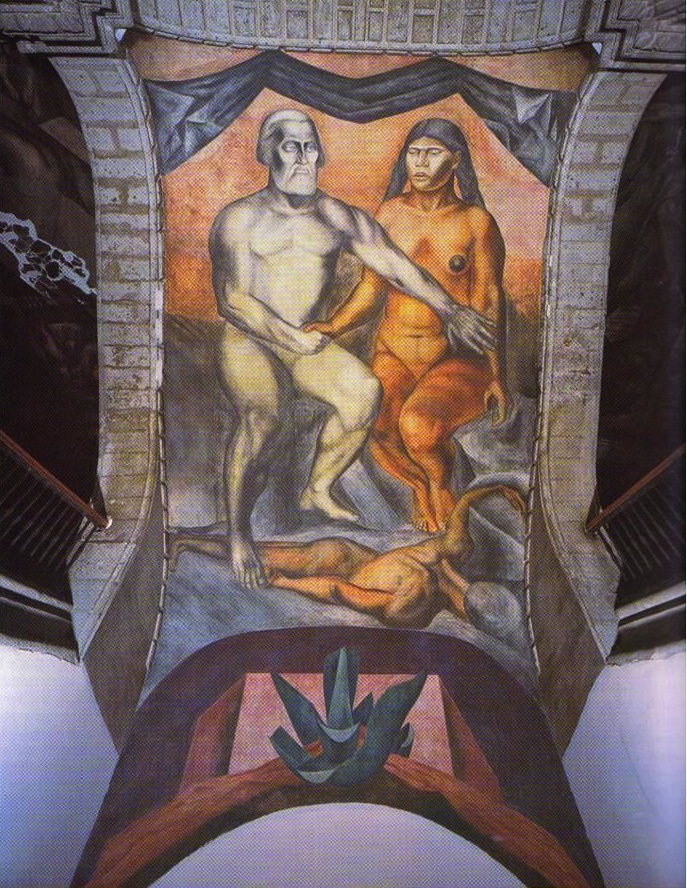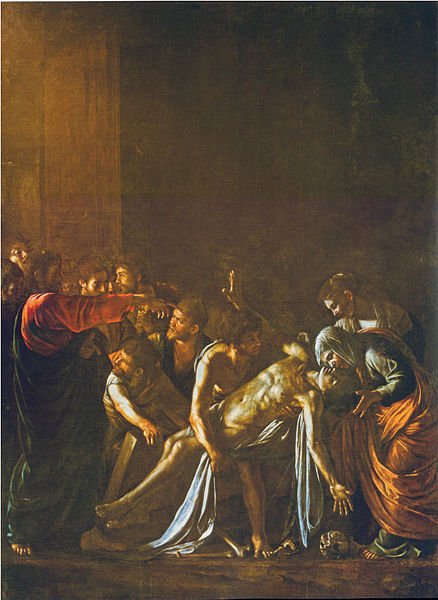José Clemente Orozco was the oldest of Los Tres Grandes, the celebrated modernist painters who led Mexico’s twentieth-century muralist movement. Among “The Big Three,” he was also the least politically dogmatic and the most outwardly pessimistic. Whereas Diego Rivera idealized the armed struggle of the Mexican Revolution (1910-20), having missed the deadliest periods of combat while active in Cubist circles in Paris, Orozco was haunted by the carnage and chaos he had witnessed firsthand. Like Rivera, David Alfaro Siqueiros—a brazen militant and diehard labor organizer—often depicted the revolution and the future of the nation through the image of the worker at the center of industrial modernity.
Although Orozco portrayed the Mexican proletariat, which was (and still is) mostly indigenous and Mestizo, he viewed the industrialization that was welcomed by his fellow painters as having paved the way for the lethal arsenals of modern political conflicts. Moreover, when depicting the European conquest(s) of Mexico and the sociopolitical history that followed—from the colonial caste system to the instability of the revolutionary era, Orozco was visibly skeptical of power. The biting stylization that he honed while working as a political caricaturist before launching his career as a painter resurfaced throughout his more than twenty years as a muralist— frequently landing the artist in the center of heated controversy.
One of the first works of the muralist movement was executed by Diego Rivera in the Bolivar Amphitheatre of the National Preparatory School in the nation’s capital. “Creation” (1922-23) shows a series of aestheticized religious figures standing beneath a celestial canopy as they flank the natural world. Having just returned from Europe, where in addition to spending time in France he traveled to Italy, the influence of Byzantine and Renaissance painting was still fresh in Rivera’s mind. The mural is also representative of the romanticized nationalism that was advocated by José Vasconcelos, the Secretary of Public Education under revolutionary president Alvaro Obregon, who organized an extensive public art program as part of larger reform. Vasconcelos’ theory of a “cosmic” race of Mestizos (those of mixed ancestry) proposed “modernization” through the assimilation of the country’s diverse population into a single ethnic identity--the anti-indigenous and patriarchal undertones of which have been criticized by numerous scholars and artists since it was initially suggested as a guideline for commissioned painters.
 [Diego Rivera, "Creation" (1923). Image from the author`s archive.]
[Diego Rivera, "Creation" (1923). Image from the author`s archive.]
Nevertheless, it was Vasconcelos who urged Rivera to travel to the Oaxacan district of Tehuantepec in order to reconnect with Mexican visual culture after his long absence. The artist’s sojourn coincided with an interest in Pre-Columbian art that was sparked by the lectures of painter Adolfo Best-Maugard, who developed a modern drawing technique based on Indigenous art. Although Rivera traveled to Tehuantepec while working on “Creation,” the impact of his research was not visible until he began his Ministry of Education mural cycle a few months later. In his Court of Labor panels from 1923, the round, soft-edged figuration of early Renaissance frescoes is combined with the geometric division of space and dimensionality of Pre-Columbian sculpture. In their use of light and perspective to accentuate a certain tonality, these detailed scenes of the revolution (and the sweeping agrarian developments it induced) similarly borrow from fifteenth-century European examples (see David Craven’s Art and Revolution in Latin America 1910-1990, Yale University Press: 2002). While painting the cycle, Rivera applied an Indigenous fresco technique, which his colleague Xavier Guerrero had adapted from the materials and methods of ancient wall painting.
 [Detail of Diego Rivera`s "The Embrace" (1923). Image from the author`s archive.]
[Detail of Diego Rivera`s "The Embrace" (1923). Image from the author`s archive.]
Orozco also displayed an abrupt artistic transformation around the same time. After he began to paint the inner courtyard of the National Preparatory School as his first government-sponsored commission, he suddenly switched the direction of his proposed panels and destroyed a number of completed frescoes. The lone, surviving mural of this false start is “Maternity” (1923), a stunning homage to Baroque sensibilities that is unfortunately indebted to Vasconcelos’ outline for a nationalist aesthetic. The emphasis on Christian iconography in “Maternity” and its succumbing to the embellishments of seventeenth-century religious painting has been jointly attributed to the influence of Gerardo Murillo (also known as Dr. Atl), a leading Mexican painter who instructed Orozco, Rivera, and Siqueiros, among others, at the Academy of San Carlos. Atl was staunchly anti-colonialist and had called for a “national” modern art movement prior to the revolution. As their teacher, he was a great supporter of emerging painters and championed Rivera’s early engagement with Cubism by lobbying officials to finance his trip to Europe. Atl’s curious interest in the spiritual and symbolist aspects of Renaissance painting (which inspired him to create pre-revolution frescoes and to propose the national mural project to Vasconcelos) had a profound effect on Orozco. The superb formal quality of “Maternity” aside, the panel’s concept is inapt and unrefined considering the populist tide of post-revolution political life (see Desmond Rochfort’s Mexican Muralists, Chronicle Books: 1993).
 [José Clemente Orozco`s "Maternity" (1923) with a portion of his later mural "Destruction of the Old Order." Photographed by the author.]
[José Clemente Orozco`s "Maternity" (1923) with a portion of his later mural "Destruction of the Old Order." Photographed by the author.]
In 1923, although the morale of those who had sided with revolutionary forces was high, a significant opposition remained. A succession of attempted coups and political assassinations sobered many artists as the reality of the surrounding political climate began to play an undeniable role in steering the modern art scene. During this early period of experimentation, Orozco grew increasingly cynical about the prospects of the nation’s advancement among warring factions. In the Ministry of Education, Rivera’s second go at mural painting reflects a backing of the revolutionary policies that were introduced by the Obregon administration with a focus on labor and education reform. Siqueiros followed along the same path as Rivera through the Syndicate of Technical Workers, Painters, and Sculptors, an organization of muralist and other commissioned artists that they established with Xavier Guerrero. Rivera and Siqueiros wrote for the Syndicate’s El Machete newspaper while Orozco contributed scathing political cartoons to the graphic-art oriented periodical. El Machete was printed in red and black typeset for easier reading when plastered on public walls.
Despite his nominal participation in the union’s zealous activism, which was largely affiliated with the local Communist Party, Orozco took to channeling his frustration through several 1924 panels on the ground floor of the National Preparatory School. His grotesque portraits of the wealthy and unflattering depictions of revolutionaries drew vast criticism when they were unveiled, and he was quickly dismissed from the project. Without exception, the muralists roused detractors from all sides; yet they emerged defiantly confident as the movement progressed and their public works became the face of Mexico’s revamped civil infrastructure. During tense periods of attack and censure, Rivera and Siqueiros were known to arm themselves and their assistances while painting.
1924 was also the year that Vasconcelos resigned from his post as Secretary of Public Education in protest of Plutarco Elias Calles who succeeded Obregon. As president, Calles announced plans for a staggering overhaul of Mexico’s domestic policy in an attempt to meet the standards of the 1917 constitution, pledging greater land redistribution and the expansion of the previous administration’s education program. He also sought to establish a significant platform for labor unions. Although widely supported by the Mexican left during his initial time in office, Calles’ atheist views and anti-Catholic stance, which inspired a set of 1926 laws that banned religious schools and stripped the Church of property rights, made him a divisive figure.
Historians tend to disagree on why Orozco chose to spare his “Maternity” scene, which was attacked by a group of Catholic women who (ironically) deemed it sacrilegious. Of the artist’s many frescoes exploring Mexico’s epic narrative (including murals in the US), his 1926 National Preparatory School panels of the Spanish conquest are perhaps most damning with overt references to the sexual violence that defined the founding of New Spain. As he resumed his commission for the institution, his approach also became starkly pensive in an additional grouping of frescoes that ushered in the pluralist nature of the muralist movement. Sharing a wall with “Maternity” is Orozco’s masterwork: “The Trench” (1926), a disconcerting yet restrained depiction of the revolution’s violence. Abandoning the airy and robust physicality of his previous “nationalist” rendering, his figures are painted with the formal temperament of early twentieth-century expressionism and the muscularity of Toltec stone carving. Against a jagged boulder, three soldiers are frozen in motion as they fall to their deaths, their nearly fixed bodies forming a tilted crucifixion.
.jpg) [José Clemente Orozco`s "The Trench" (1926). Photographed by the author.]
[José Clemente Orozco`s "The Trench" (1926). Photographed by the author.]
Christian iconography continued to be employed as a recognizable mode of representation as the movement became increasingly aware of the reflective cultural engagement that was needed. What changed from the time of Vasconcelos’ influence, however, were the forms and concepts that artists applied to such imagery in the fashioning of “national” significations. In place of replicating the aesthetics of Renaissance and Baroque icons, the muralists developed distinct modernist styles while altering the basic components of biblical compositions. They replaced saints and martyrs with Indigenous and working class subjects and incorporated the popular vocabulary of folk art, which regained cultural currency during the revolution as a rejection of the racial and class-based hierarchy of hacienda order, especially through the satirical graphic work of José Guadalupe Posada. Although this methodology might seem paradoxical, it was not the first time in Mexican history that religious (essentially colonial) imagery had been appropriated and rebranded with revolutionary signifiers in reference to Indigenous origins. During the Mexican War of Independence (1810-1820), which began as a peasant revolt, the image of the Virgen de Guadalupe became a nationalist symbol when it was reproduced on the banners of Criollo (Mexican-born Spaniards), Mestizo, and Indigenous rebels, who jointly called for the overthrow of the colonial government. This “distinctly Mexican” apparition of the Virgin Mary has been the country’s patron saint since it came into prominence in the sixteenth century. As the symbolic makeup of icons is akin to the pictorial system of Pre-Columbian ceremonial art with its emphasis on creation, sacrifice, and rebirth, the image of the Virgen was generated to reinforce the mystic parallels of Catholicism and Mesoamerican religions during the mass conversion of local populations. The muralists recurrently revisited such interchangeable visuals when seeking to undermine the social remnants of colonialism.
 [Original version of the Virgen de Guadalupe painting (ca. 1531). Image via Wikimedia Commons.]
[Original version of the Virgen de Guadalupe painting (ca. 1531). Image via Wikimedia Commons.]
“The Trench” is at once tragic and heroic. Mexican scholars cite it as the first modern work to deal directly with the underside of the revolution, which left at least one million dead. Others have observed a sense of ambivalence: Orozco’s figures are captured in their descent but are shown with controlled movement and theatric grace, displaying the utmost dignity in their last breaths. At the time of painting his 1926 murals, Orozco had (yet again) repositioned his artistic take on national subjects; adopting a muted palette and greater definition and angularity in the depiction of his figures, he linked them to volcanic landscapes. In these panels, light is reflected onto the bare flesh of their bodies with highlights and shadows that seem to emanate from massive rocks. Also demonstrating this new aesthetic are “Cortés and Malinche” (1926) and “Franciscans Helping the Sick” (1926), two ceiling frescoes that he painted near a stairway on the ground floor.
“Cortés and Malinche” is particularly noteworthy when considering his revised approach, as it demonstrates the semiotic strategizing with which he returned to complete his commission. Malinche was a young sixteenth-century Indigenous slave who acted as an interpreter for the Spanish conquistador Hernan Cortés and later bore his son. For centuries, the historical recounting of Malinche’s experience, although based in fact, has been merged with popular legends and confounded with politicized meaning. A polarizing figure, some consider her to be the symbolic matriarch of Mestizos; others view her as a traitor to the native inhabitants of Mexico. Orozco’s mural plays with both views and adds another alternative: that of a woman who was forced into submission and has been unjustly positioned as the instigator of Mexico’s downfall. The artist cleverly turned to iconography to secure his mural as a historical reading and to challenge Mexican mythos. Using the space between the archways of two stairwells, he reproduced the vertical composition of the venerated Virgen de Guadalupe image. Cortés and Malinche are seated as the divine focal point while the crescent moon and angel that normally prop up the floating Marian vision (presumably Mexico rising under Catholicism) are inverted and painted as the corpse of an Indigenous man who lies beneath the conquistador’s foot. Malinche attempts to move forward but is stopped by Cortés’ forceful grip.
 [José Clemente Orozco`s "Cortés and Malinche" (1926). Image from the author`s archive.]
[José Clemente Orozco`s "Cortés and Malinche" (1926). Image from the author`s archive.]
“The Trench” is comparatively subdued in its use of religious symbolism and historical sampling. An adjacent 1924 panel titled “The Revolutionary Trinity” shows an armed rebel who is blinded by a red flag while workers kneel before him (one in disgust, another in fear), leading the viewer to believe that the general mood of this specific corridor in Orozco’s ground-floor mural cycle is decidedly embittered and fatalistic. Nonetheless, the stillness and palette of “The Trench” suggest a view of the revolution’s darkest moments from a distance without emotive accents. A glimpse into the artist’s thinking at the time is provided in the mural section “The Destruction of the Old Order” (1926), which is situated between “Maternity” and “The Trench.” The fresco contains a scene of two men, a worker and a revolutionary soldier in rural garb. Turned with their faces partially hidden, they look back at the ruins of buildings; the painting’s title suggests the collapsed columns, walls, and bell towers of ruling institutions. A portion of the panel’s background flows in from the rock formation of the “The Trench,” linking the two as part of a broader narrative. Even more telling is that “The Trench” seems to be based on Michelangelo Caravaggio’s “The Raising of Lazarus” (1609). Orozco’s variation compacts Caravaggio’s composition, utilizing its staging of figures as the basis for his operatic scene. A comparison of key gestures from left to right reveals the extent to which Orozco worked from Caravaggio’s composition: Christ’s extended arm, emphasizing the miraculous moment, becomes that of the freefalling soldier whose back is to the viewer; Lazarus’ resuscitated body is the centralized protagonist of Orozco’s suspended disaster while the folds of the blue cloth beneath the saint direct the placing of his bent soldier; the contrapposto pose of the Virgin Mary has been abstracted into the right side of the boulder, appearing to support the weight of the middle figure. Formal elements such as the perpendicular partition of the picture plane and the directional source of light that are found in “The Trench” also correspond to the chiaroscuro example. Through Caravaggio the viewer becomes aware of the philosophical nuance of Orozco’s condensed panorama. His anonymous figures, said to represent the devastation of the revolution, are, in fact, rising.
 [Michelangelo Caravaggio`s "The Raising of Lazurus" (1609). Imave via Wikimedia Commons.]
[Michelangelo Caravaggio`s "The Raising of Lazurus" (1609). Imave via Wikimedia Commons.]
From “Maternity” to “The Trench,” Orozco singlehandedly outweighed a critical facet of Mexico’s visual history. In “Maternity” he utilized the traditional imagery of icons to project the movement’s aspirations for the birth of a new national culture, reproducing an image that had long been held as universal to imply greater collectivity. Although “The Trinity” reflects his disappointment and palpable outrage at the opportunism of some revolutionary forces, it also exhibits a self-reflective deconstruction of the political inferences of icons. “Cortés and Malinche” serves as the pinnacle image of this rigorous process. “The Trench” presents a new point of reverence: the ascension of a people amidst a land that (while shrouded with the remains of cultural rupture) has provided a setting for regeneration.
In just three years, José Clemente Orozco traversed the colonial legacy that overwhelms modern day Mexican visual culture, exiting its maze of signs with profound clarity. Despite Diego Rivera’s dominance of the muralist movement and an intense rivalry between the two painters, in the 1940s, when the Mexican school had reached international influence, he recognized Orozco as “the greatest painter Mexico has produced.”